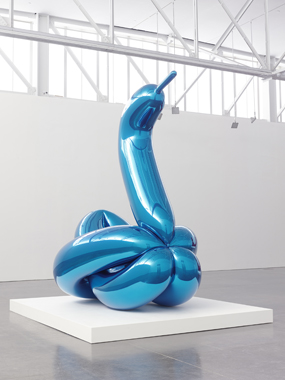
Jeff Koons, Balloon Swan
- Immediate Response
The artwork Balloon Swan by Jeff Koons initially brought up memories of childhood. I recalled going to carnivals or street fairs as a kid and getting balloon animals from performers or clowns. People would walk around with balloon animals, balloon hats, and even balloon swords. My immediate response therefore, was one of nostalgia and comfort. Following the sense of nostalgia was an appreciation for the scale of the work, as well as the shine on the material. The sculpture stands over three meters tall, and is entirely made of coated steel. I immediately made the connection between a delicate, lightweight balloon and this heavyweight, steel structure balloon representation.
- Objective Description
Balloon Swan appears to be a long, tubular, blue balloon folded and creased into the form of a bird, specifically a swan. The base is vaguely repetitive, with the “balloon” appearing to be folded and looped back and forth onto itself to create a basket-like structure. The balloon then extends upward into the neck of the swan, more than doubling the height of the base, and ending in the beak, which appears to be the nub end of the balloon with no air in it. The entire “balloon” is steel, polished with a chrome blue coating, giving the sculpture a mirror-like finish and straying away from the realistic interpretation of a carnival balloon animal.
- Technical Decisions
This work is large scale and made of pure steel, so the element of construction is especially pertinent when analyzing technical decisions. I believe that Koons took on a challenge when making the decision to create a sculpture representing a flexible material, but creating it out of one of the most inflexible materials possible. The sculpture appears to be folded and twisted easily, yet the process of manipulating steel was most likely strenuous. The presentation of the structure additionally contrasts with the chrome coating applied to the exterior. Balloon Swan sits on a plain white base, accessible for viewing on all sides. The chrome of the swan pops out against the white base, and the all-accessible sides allow the view to take in the full dimensionality of the work.
- The Work in the World
Koon’s Balloon Swan draws connection to two seemingly mundane objects or animals: balloons and swans. The connotation these chosen things hold contribute to the implied meaning of the work. Swans are considered to be graceful, much like the grace in which a balloon is carefully twisted into something it’s not. But while swans are beautiful, they can also be stubborn and feisty, which alludes to the choice of material as steel, which is harsh and unforgiving. Balloons are delicate and playful. The element of delicacy is juxtaposed with the metallic material, as well as the metallic chrome effect. The playfulness is apparent in the association with balloons, and the connection they have to celebrations, carnivals, or parties. Koons makes numerous works of art surrounding the idea of balloon animals, each animal representing something different, such as his balloon rabbits which make statements about Playboy magazine and sexualizations within art.
- The Story it Tells
Although appearing to be simply a representation of a common object, the messaging behind the work is clear. Koons focuses on juxtaposition of the everyday and the monumental. By taking well known, pop culture, everyday objects and placing them in a gallery or museum space, he is elevating the object to a new level of importance, similarly to the Readymades of Duchamp. The imagery of a balloon itself ties into notions of fragility, commenting on how delicate objects can be impermanent. He reassures us to not feel overwhelmed by this by implementing steel as his main media: structure in an otherwise flimsy object. The final note Koons hints at is our personal human condition. To blow up a balloon, it requires air. Like humans, these balloons need air to exist, and Koons draws this connection quite literally with his choice of subject matter. Overall, Koons portrays the idea that, although nothing will last forever, we need to keep breathing and keep going, trusting that as fragile as things may seem, they are always stronger than they appear.
